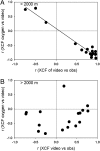Role of macroscopic particles in deep-sea oxygen consumption
- PMID: 20406905
- PMCID: PMC2889554
- DOI: 10.1073/pnas.0913744107
Role of macroscopic particles in deep-sea oxygen consumption
Abstract
Macroscopic particles (>500 mum), including marine snow, large migrating zooplankton, and their fast-sinking fecal pellets, represent primary vehicles of organic carbon flux from the surface to the deep sea. In contrast, freely suspended microscopic particles such as bacteria and protists do not sink, and they contribute the largest portion of metabolism in the upper ocean. In bathy- and abyssopelagic layers of the ocean (2,000-6,000 m), however, microscopic particles may not dominate oxygen consumption. In a section across the tropical Atlantic, we show that macroscopic particle peaks occurred frequently in the deep sea, whereas microscopic particles were barely detectable. In 10 of 17 deep-sea profiles (>2,000 m depth), macroscopic particle abundances were more strongly cross-correlated with oxygen deficits than microscopic particles, suggesting that biomass bound to large particles dominates overall deep-sea metabolism.
Conflict of interest statement
The authors declare no conflict of interest.
Figures




References
-
- Turner J. Zooplankton fecal pellets, marine snow and sinking phytoplankton blooms. Aquat Microb Ecol. 2002;27:57–102.
-
- Fowler SW, Knauer GA. Role of large particles in the transport of elements and organic compounds through the oceanic water column. Prog Oceanogr. 1986;16:147–194.
-
- Michaels AF, Silver MW. Primary production, sinking fluxes and the microbial food web. Deep Sea Res. 1988;35:473–490.
-
- Suzuki N, Kato K. Studies on suspended materials. Marine snow in the sea I. Sources of marine snow. Bull Faculty of Fisheries, Hokkaido Univ. 1953;4:132–137.
-
- Alldredge AL, Silver MW. Characteristics, dynamics and significance of marine snow. Prog Oceanogr. 1988;20:41–82.
Publication types
MeSH terms
LinkOut - more resources
Full Text Sources
Other Literature Sources

